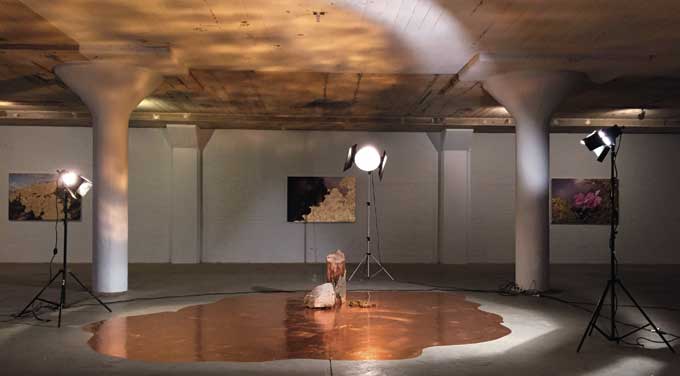Next story: Buffalo and the BPO bid farewell to Maestro Paul Ferington
In a Fog
by Jack Foran

New Exhibit at Hi-Temp features David Mitchell, Max Collins, Flatsitter
The common subject matter among the three components—two visual and one audio—of the current show at Hi-Temp is nature. The visual components—by David Mitchell and Max Collins, respectively—compare and contrast as cerebral to visceral. The audio component, by the group Flatsitter, provides transition between the visuals.
Mitchell’s work—the more cerebral visual—is about nature and the environment in a transcendentalist quasi religious mystical vein, with art historical reference to Hudson River School paintings and philosophical reference to Ralph Waldo Emerson, amid various current culture photographic or cinematic references.
More puzzling in the nature and environment general context is copious elemental gold or gold facsimile, including an apparent pool of molten or formerly molten gold around a tree stump and large rock in the center of the exhibit space. A kind of alternative version Zen meditation rock garden? A golden age reference? Something about cinematic world glitter, dazzle? Another floor space sculptural item is a loose pile of crumpled scraps and bits of gold leaf. The gold pool and gold leaf works are lit by photo studio apparatus lights, compounding the puzzle.
While along the walls, a series of large-format photo reproductions on canvas of Hudson River School paintings—works of Thomas Cole, Jasper Francis Cropsey, Frederic Church, and Albert Bierstadt—each obliterated in large part and various portions by thick overlays of crinkly gold leaf. One of these—which may be key somehow to the whole exhibit—the Cole painting of the expulsion of Adam and Eve from Eden. Amid some spectacular rocky landscape, the couple are shown exiting left, glancing backward at a kind of solar light manifestation—Jahweh, clearly—mostly hidden by an enormous foreground rock. All that we see are some light beams radiating out from behind the rock.
How maybe key? In all the paintings the obliterating gold overlay functions as a kind of theogenic blinding light deprivation of the (Hudson River School) Eden vision. Like the more literal Jahweh light—and expulsion order—in the Cole work.
Seeming to underscore the centrality of the Cole work, a wall sculpture—the only one in the Mitchell exhibit—consists of a large star form of radiating blinking fluorescent lights. The Jahweh light again.
Another floor sculpture consists of photo studio lights and—on the floor, so you’d have to crouch or kneel down to read it—the first page of Emerson’s essay “Circles.” Emerson calls the circle the “primary figure,” and a symbol of “the moral fact of the Unattainable,” and recalls that “St. Augustine described the nature of God as a circle whose center is everywhere, and its circumference nowhere.”

Mitchell’s installation is a meditation on nature and the environment. Max Collins’s is the creation of an environment. In a dark space—a different room than Mitchell’s—further obscured atmospherically by a generously productive fog machine, Collins has two roughly mound-like works. One a kind of cross between a teepee and a log cabin of wheat-pasted white-paper-covered poles—thinnish logs—and wheat-pasted paper in the interstices between them. One a less elegant construction pile of logs or logs and other materials, covered with a huge white plastic sheet. As far as one can tell. The little light in the room mostly from a lamp under the teepee/cabin construction. And around and about, more wheat-pasted white-paper-covered poles, leaning against the old industrial building veritable forest of vertical support timbers or exposed ceiling joists. Other raw wood strips, chips, bark, strewn on the floor. You feel this detritus underfoot more than actually see it in the darkness.
So a kind of fog forest environment, slightly spooky, primal, uncanny. Back in around the 1970s there was an out-of-category artist genius in Buffalo by the name of Joe Dunn, who among other projects created a series of semi-theatrical-event environments in totally darkened and silent spaces into which audience would enter and be dumbfounded, hearing and seeing nothing at all for ten or twenty minutes or so—just vaguely aware of the presence of other audience—until somewhat becoming acclimatized to the sensory deprivation environment, maybe something appeared, something faint and undecipherable. Maybe real, tangible—but you couldn’t touch it—or maybe largely in your head. It was the era of art experience so-called happenings, but I think Joe Dunn’s land of unlikeness creations went beyond any mere happenings. Undefinable experiences, but intense. Collins’s project is a little like one of Joe Dunn’s creations.
About the fog machine. After I viewed the exhibit, I walked over to the Canalside Tim Horton’s for a cup of coffee—I was waiting for someone at Hi-Temp and had fifteen minutes or so to kill before they were supposed to get there—but first mentioned to one of the Hi-Temp people about the prolific fog machine, how you could mistake that there was a fire. I suggested that, as no one was viewing the exhibit just then, they shut it off. I got my coffee and immediately returned. As I re-approached Hi-Temp there were about five fire engines on the street in front of the building and firefighters were exiting the building, having determined, apparently, no fire, just the fog machine.
The Hi-Temp exhibit is up until July 3. Viewing is by appointment. Call 852-5656.

|
Issue Navigation> Issue Index > v14n26 (Week of Thursday, July 2) > In a Fog This Week's Issue • Artvoice Daily • Artvoice TV • Events Calendar • Classifieds |









 Current Issue
Current Issue